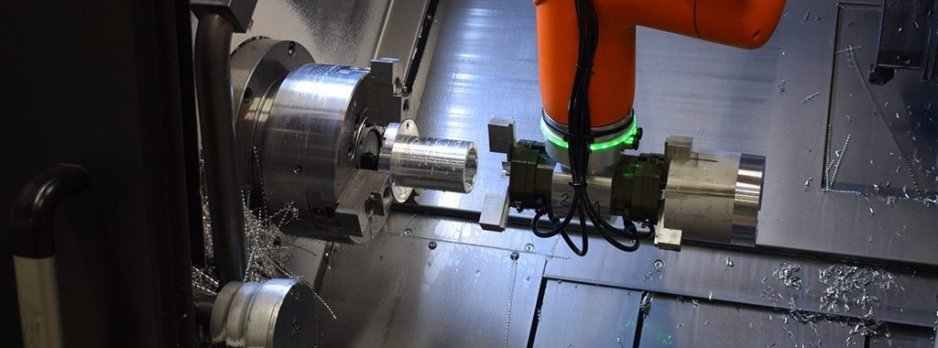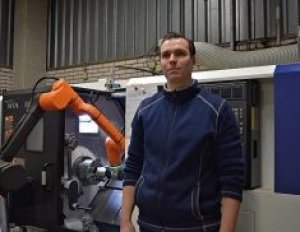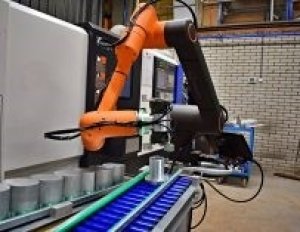Dutch firm MQ Statieven uses their Hanwha HCR-12 for space saving automation
Robotics and Automation is getting just that little bit closer, giving everyone in the UK the chance to see the Hanwha HCR-12 in action. The Hanwha cobot dealer in the Netherlands, Dymato, told us how their customer MQ Statieven is getting on automating their production line with the HCR-12. Take a look at what they’ve got to say below.

MQ Statieven in Etten-Leur has recently started automating their production line. Their work includes handling raw rod material and tubes and the tripod manufacturer has opted for a Hanwha cobot. The cobot has only been operational since November, but they’ve already seen a considerable productivity gain.
MQ Statieven produces tripods for industry, earthmoving, construction and rail construction. These stands are marketed worldwide. “The stands that we produce belong to the top segment and are used by companies that care about quality and sustainability. Every now and then we get questions for replacement parts of tripods that are more than 25 years old. Companies purchase our tripods for life. In addition, our customers use the tripods to position expensive measuring equipment, where stability is very important. That is why we strive to produce reliable and high-quality products” says Frank van Dongen, director of MQ Statieven.

Experience with robots
Van Dongen took over the company last year and soon saw where production could be optimized. “I previously worked for a production automation company that makes robot welding lines for the automotive industry, among other things. As a result, I know what is possible with robots and what an investment in automation will ultimately yield. If I had previously worked at MQ Statieven, I would have invested in automation earlier”. The reason that MQ Statieven opted for a cobot and not for an industrial robot or an automation cell has to do with the available space in the workshop. Because cobots have been developed to work with people, they do not need large safety cages, fencing or sensors. As a result, the space occupied by a cobot is beautifully compact. In addition, MQ Statieven only produces light aluminum workpieces in series of twenty to a few thousand pieces. A cobot is extremely suitable for handling these products.

The cobot does the boring works
MQ Statieven uses the cobot purely for machine loading. The system grabs raw material, then removes the processed product from the chuck, exchanges it with the raw material and then places the processed product on a conveyor belt. This way employees are relieved of the boring work, giving them more time for more important things, such as making grippers for the robot so that production can be further scaled up. “We are a small but growing company. What we encounter is the lack of technical staff. You can work harder with the same amount of people, but you will not make it in the long run. That is why we must look for smart solutions. Having a robot take the monotonous work off your hands is a perfect example of this. Cobots are often advertised as machines that can work together with people. I don’t see that happening so quickly. People have to keep an eye on everything and ensure that the production process can continue. The robot just has to do the work”.
Up to 12kg
The cobot that MQ Statieven has purchased is the Hanwha HCR 12. With a reach of 1,300 mm, this is the heavy duty version with the longest arm, lifting workpieces up to twelve kilograms. Van Dongen points out “We have looked at several brands of cobots, but the HCR 12 was the most suitable for our application”.
Productivity gain
MQ Statieven has placed the Hanwha cobot on a foot, making it mobile. This makes it easy to move the cobot from one machine to the other with a pump wagon, taking only 15 minutes to set the cobot up on a new product. This makes automating small series very quick. At the moment, the cobot is only operational during the day shift. The intention is to also start working with the cobot unmanned in the future. Then the smaller series can be handled during the day and the large series in the evenings. According to Van Dongen, the cost of the cobot is recovered within a year, when the system is only used during day shifts. “The efficiency of a robot is of course much greater than that of a human. The robot continues to work during breaks. That is twelve percent productivity gains in one day. In addition, the robot changes a product within twelve to twenty seconds, day in and day out. The cobot has only been here since November, but we can already say that we are running about a 30% increased production with the HCR-12. And that’s just the beginning of possibilities that a cobot offers. In the future, we expect to automate assembly as well as unmanned production. A second cobot is almost on the schedule in that regard”.
You can see the Hanwha HCR-12 cobot for yourself at Robotics and Automation at the Ricoh Arena in Coventy (CV6 6GE), 29 & 30 October, Dugard are on stand 412. If you can’t make it you can always pop down to Hove for a demo, give us a call on 01273 732286 or email [email protected] for more info